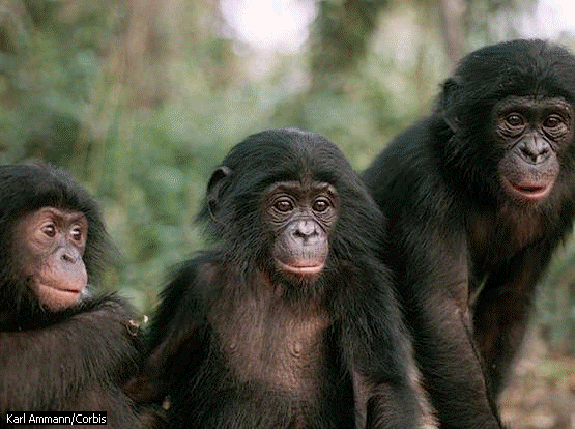


Chimpanzees of equatorial Africa are physically and genetically the animal most closely related to humans. Two species of chimpanzee exist, the common chimpanzee and the bonobo, also known as the pygmy chimpanzee. The common chimp is found in dense jungle and more open wooded savanna from Sierra Leone and the Republic of Guinea on the Atlantic Ocean to the lakes Tanganyika and Victoria in east central Africa. The bonobo is found only in a small region of thick jungle in the Democratic Republic of the Congo (formerly Zaire) in central Africa. Both species of chimpanzee are listed as endangered species in the wild by the World Conservation Union.
The male common chimp is up to 5.6 ft high when standing, and weighs as much as 154 lb; the female is somewhat smaller. The common chimp's long arms, when extended, have a span half again as long as the body's height. The bonobo is a little shorter and thinner than the common chimpanzee but has longer limbs. Chimpanzee feet are better suited for walking than are those of the orangutan because the chimp's soles are broader and the toes shorter. The coat is dark; the face, fingers, palms of the hands, and soles of the feet are hairless; and the chimp has no tail. A bony shelf over the eyes gives the forehead a receding appearance, and the nose is flat. Although the jaws protrude, the lips are thrust out only when a chimp pouts. The brain of a chimpanzee is about half the size of the human brain.
The chimpanzee is awake during the day and sleeps at night. They eat, about 200 kinds of leaves and fruit; termites, ants, honey, and birds' eggs; and birds and small mammals. It lives in or near trees, avoiding direct sunlight. An adult builds a sleeping nest each night in a tree. The female has a 35-day menstrual cycle, is receptive to mating for 6.5 days out of each cycle, and can breed at any time of the year. The female may mate with different partners. The gestation period is more than seven months long, and a single offspring or rarely, twins, is produced. Immediately after birth the helpless young clutches its mother's hair, riding on the mother's back when she travels. Common chimps are weaned at about four years, and bonobos are weaned at about five years. In both species, the young may continue to travel with the mother until the age of ten. Offspring sometimes maintain a bond with the mother throughout life. Chimps in the wild live about 40 years and many in captivity live over 50 years.
Chimpanzees form loosely organized bands of 2 to 80 individuals on fairly large home ranges, where the animals remain for years. Within a band, smaller groups may form, break up, and re-form; sometimes a female migrates to another band. Males never migrate. Except between mother and young, little permanency exists in individual relationships. Members of a band cooperate in hunting and sharing food. On finding a food source, they hoot, scream, and slap logs to attract others. A constant interplay occurs between adults, and all members of the group groom one another.
Chimpanzees communicate through vocalizations, facial expressions, posture, touch, and movement. A young chimp is able to make at least 31 different sounds, and the facial musculature can express a wide range of emotions. The animals show great intelligence in problem solving and the use of simple tools, such as a stripped twig used to draw termites from their nests. A number of experiments have shown that chimps can even learn to use sign language or other languages based on pictures or symbols.

The greatest threats to chimpanzees are the continued loss of habitat to logging and agricultural development, and the hunting of chimps for export to zoos, for scientific research, and food. Conservation efforts that prohibit the hunting and sale of chimpanzees provide some protection; however, these bans are difficult to enforce. Sanctuaries for orphaned and recaptured animals provide the common chimp with additional protection in Zambia and Gambia, as does Salonga National Park for bonobos in the Democratic Republic of the Congo.
Scientific classification: Chimpanzees belong to the family Pongidae in the order Primates. They make up the genus Pan. The common chimpanzee is classified as Pan troglodytes. The bonobo is classified as Pan paniscus.